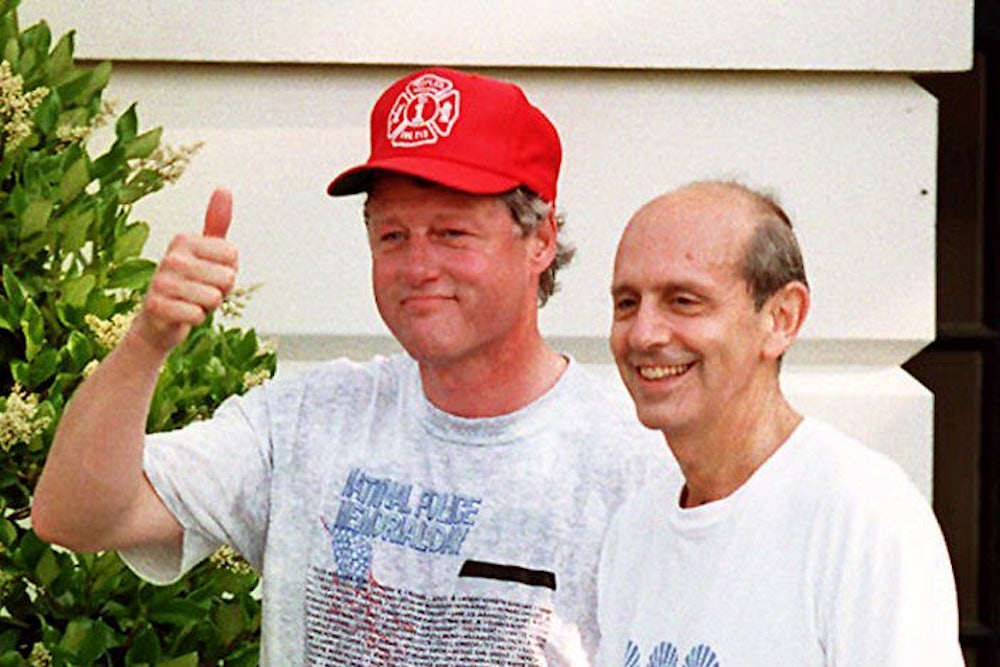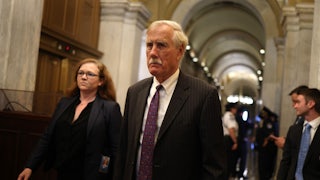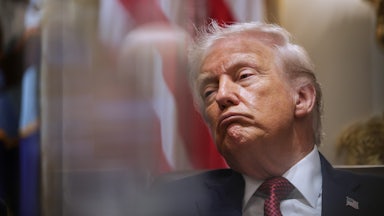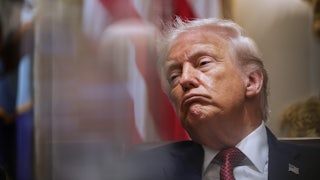When Stephen Breyer declared at the White House that the role of a justice is to “make life better for ordinary citizens,” perhaps it wasn’t too much of a stretch to think of Coriolanus’s efforts to pay obeisance to the common man. For populist rhetoric does not come easily to a judge who has e-mail debates with his son about Don Quixote; who, at the age of 19, was arrested with his Norwegian girlfriend in a San Francisco opera bar for ordering red wine as a minor; and who, during a fireside game of charades at the family Christmas party last year, acted out The Epic of Gilgamesh. (His daughters, according to a guest, rolled their eyes indulgently, as if to say: “Oh, Daddy, not The Epic of Gilgamesh again!”)
Even Breyer’s self-possession during the brutal selection process that led to his Supreme Court appointment had an offbeat charm. When he returned from Washington after his unsuccessful interview with President Clinton for Byron White’s seat last year, he exclaimed to his clerks, “Now we can sit around and watch French movies.” As his candidacy waxed and waned the second time around, and friendly moles in the White House gave him up-to-the-minute reports, Breyer would joke: “It reminds me of the Phoenix, rising from the ashes.” And he became so excited, while reading Proust recently, by a reference to Louis XIV’s courtier, Madame de Sevigne, that he rushed to the library to track her letters down.
In light of Breyer’s appealing, slightly eccentric refinement, perhaps the populist packaging is unavoidable. After all, Ruth Bader Ginsburg had her mother, and Clarence Thomas his grandfather, and David Souter his youthful ordeal as a Harvard abortion counselor, to warm the hearts of the sentimental Senate. Stripped of its populist veneer, however, Breyer’s statement in the Rose Garden—”the Constitution and the law must ... work as a practical reality; and I will certainly try to make law work for people”—is entirely consistent with his unsentimental vision of law over the past three decades. It reflects a legal tradition, neo-pragmatism, that has absorbed Breyer ever since his student days at Harvard Law School, and has guided him as a government lawyer, a scholar and a judge.
What does Breyer’s pragmatism say about the kind of justice he might become? After reading the voluminous speeches and writings and opinions that he supplied to the Senate, it’s hard not to be impressed with the range of his interests. He has a rare ability to dive into unfamiliar, highly technical subjects, to grasp their analytical essence and then to synthesize and rationalize them in a relatively accessible way. (His confession in January that “I set for myself a goal of trying to write my opinions so that a high school student” would understand them, however, reflects an extremely rarefied view of high school.) In his areas of scholarly expertise—administrative law and regulation—Breyer’s suspicion of overarching theories, and his habit of testing his doctrinal conclusions against their practical implications, should be a powerful antidote to the anti-pragmatic, anti- empirical formalism of Antonin Scalia.
Constitutional law, however, is not a subject Breyer has written very seriously about. And his isolated encounters with constitutional issues—such as his breezy invocation of the Ninth Amendment in Griswold v. Connecticut, the landmark right to privacy opinion he helped to write as a law clerk for Arthur Goldberg—are not always entirely convincing. Appearing with Harvard colleague Laurence Tribe at the Kennedy School of Government in 1991, Breyer joked about his youthful handiwork:
I like to point to the Ninth Amendment, because I was the law clerk for Justice Goldberg when he wrote an opinion called Griswold v. Connecticut... Justice Black in dissent had said there is no right of privacy, no right of marital privacy, because it isn’t listed explicitly. And Justice Goldberg’s concurrence said, “But remember the Ninth Amendment.” It says don’t take the enumeration of some to mean that there aren’t others. Don’t do that... It’s an instruction to judges. Do you see? And well then, what rights are these other rights? That’s a good question; Professor Tribe will explain it.
The central question for the Breyer hearings, then, is whether Breyer is so averse to constitutional theory that he has no broader vision of the Constitution. Would he, in constitutional cases, always reach pragmatic, politically sensible results, or does he have a less ad hoc conception of text, history and structure that is attentive to principled limitations on judicial power? Although Breyer’s instincts are moderate rather than activist, his pragmatism raises questions about judicial legislation that might be useful to explore.
Breyer’s interest in pragmatism dates back to his undergraduate days at Stanford, where he studied philosophy with Herbert Morris. As a student at Harvard Law School in 1964 Breyer wrote his third-year paper on the pragmatism of Charles Pierce, William James and Willard Quine. Invoking Quine’s metaphor of an epistemological “web of belief,” Breyer argued that judges should test each strand of their legal conclusions by examining the practical effects on various legal norms, such as statutes, regulations and precedents, and on political beliefs and sociological customs. When Breyer returned to the web metaphor in the Rose Garden, he practically restated his law school thesis: “There’s a whole mass of legal material that somehow, sometimes, in some way, is supposed to fit together. What it’s supposed to do, seen as a whole, is allow all people—all people—to live together in a society where they have so many different views ... so that they can work productively together.”
Legal pragmatists, of course, are an eclectic group: they include radical skeptics like Stanley Fish, feminists like Margaret Jane Radin and law and economics apostles like Richard Posner. Breyer’s jurisprudence demonstrates at least three conflicting strains of pragmatism. Sometimes he’s a common law constitutionalist, trying to rationalize and clarify unruly doctrines; sometimes he’s empirical and consequence-driven, balancing the costs and benefits of various regulations; and sometimes he’s just eclectic, mixing text, history, politics and precedent in sensible ways. But all three varieties of pragmatism are vulnerable to a common criticism—hey are potentially unprincipled, ad hoc and, when imposed by judges rather than legislators, ultimately undemocratic.
Perhaps the most useful description of Breyer’s mature strain of pragmatism is something like New Deal managerialism. In a 1993 interview on public television, Breyer declared, “Let’s say the New Deal, even in the 1990s, shouldn’t be totally dead... I’d like to say that New Democrats are pragmatic.” He then defined pragmatism as having “a certain amount of confidence” in the ability of the administrative state to allocate power in a rational way, but having “no fixed view in advance” that there is a single governmental or market solution to problems like health care and airline deregulation.
Like FDR’s pragmatic Brain Trusters, though, Breyer has been criticized as utopian and elitist. He has a wellspring of faith in the ability of expertly trained, intelligent managers (like himself) to distribute public resources rationally. As Cass Sunstein of the University of Chicago points out, the real scholarly contribution of Breyer’s 1993 Holmes lectures at Harvard, Breaking the Vicious Circle, is not his subtle and clarifying analysis of the problem of setting regulatory priorities. (This occurs when Congress spends billions of dollars to eliminate relatively trivial health risks, such as carcinogens in the workplace, and very little money on real health prevention, such as mammograms or prenatal care.) Instead, Breyer’s most creative suggestion is his call for the establishment of a corps of elite civil servants, modeled on the French Conseil d’Etat, that would be given broad discretion to make “commonsense decisions” about where regulatory dollars will do the most good.
The Supreme Court, however, is not the Office of Management and Budget. Questions such as abortion and religion and affirmative action are not susceptible to “commonsense” solutions, because no empirical or social consensus underlies them. And this, perhaps, is what Breyer skated over in the Griswold case. The formula he drafted for Goldberg represents constitutional pragmatism at its most immodest, a blank check for unelected judges to derive rights from the “collective conscience of our people,” without an intelligible methodology to guide the search. Breyer, however, does not appear to have had second thoughts. In a tribute to Goldberg, published in the Journal of Supreme Court History in 1990, Breyer invoked the Griswold concurrence as an example of pragmatic jurisprudence at its best: “ We learned a highly practical view of the Constitution. Justice Goldberg saw the Constitution as protecting basic liberties, in a practical way, a way that permitted achieving the ideal without unduly interfering with the workings of government... How could a document survive the ages, he wondered, if it were limited to the protection of specifically enumerated rights? Suppose, he asked us, that the government forced husbands and wives to live apart? Would the Constitution offer the family no protection?”
But this is an intuition, not an argument. What makes Goldberg’s concurrence in Griswold unconvincing is not his rejection of Hugo Black’s view that the Bill of Rights protects only rights that are specifically listed. It is Goldberg’s free-floating answer to the question: How can judges determine which additional rights are protected? (“That’s a good question; Professor Tribe will explain it.”) Goldberg confidently asserted that “ totalitarian limitation of family size ... is at complete variance with our constitutional concepts,” but he never provided any historical, textual or structural analysis to support his conclusion.
Breyer’s co-clerk during the year with Goldberg, Stephen Goldstein, says that he and Breyer were unconvinced by William Douglas’s majority opinion in Griswold, which derived the right of privacy from “penumbras, formed by emanations” from the Bill of Rights. “Frankly there was general dissatisfaction with the Douglas draft, to put it mildly,” Goldstein recalled. “It provoked not only giggles but guffaws. We were used to strange things coming out of that office, but that was the strangest. Steve and I both thought, and Goldberg agreed, that we couldn’t join it... The obvious thing to do was to write a straight Fourteenth Amendment, privacy, substantive due process opinion. That’s essentially what we did.”
“Steve did the research about the Ninth Amendment,” said Goldstein. “I don’t think he did all that much research because there isn’t that much research to do... There weren’t too many changes after Breyer did the first draft... He came up with what he came up with, and Goldberg ran with it. It was clearly Goldberg’s decision, but neither of us disagreed with it. We thought it was a good idea and it should be expounded.”
Goldberg never asked for any evidence, according to Goldstein, to support his view that privacy was a fundamental right. “I think he felt that it was there. I don’t think any of us did any historical or comparative or scientific research... Goldberg was quite clear that he knew what rights there were, he could identify which rights were entrenched in the conscience of the American people... Steve and I were more troubled by how one identifies those things, but once you accept that route of substantive due process, it was as good a formula as we could come up with.”
Happily, nothing else in Breyer’s record suggests a tendency to pull rights out of thin air. Ever since his law school days, as an apostle of Henry Hart and Albert Sachs, he’s been sensitive to questions about the institutional competence of judges; and his academic models, such as Paul Freund and Louis Jaffee of Harvard, have been pragmatic incrementalists rather than crusading activists. In speeches and opinions, too, Breyer has been skeptical about the proliferation of rights. In a 1989 tribute to his Harvard colleague Paul Bator, Breyer praised the “great legal tradition ... that interprets the Constitution in a manner that is fundamentally pragmatic, undogmatic, that sees law, including constitutional law, as an untidy body of understandings among groups and institutions, inherited from the past, open to change mostly at the edges.”
In a 1983 symposium on the litigation explosion, Breyer wrote: “One can at least ask whether direct governmental expenditure might do more for, say, the handicapped, or for, say, worker safety, than enforceable legal rights, for example, against discrimination,’ which may be given in principle, but perhaps too often denied in practice.”
Breyer’s restraint is obvious in many of his decisions on the U.S. Court of Appeals in Boston. Abortion rights activists are worried about his dissent in the 1989 Bellotti case, where he voted to uphold a parental consent law. But in fact, the dissent shows Breyer’s pragmatism at its best. In 1979, and again in 1983, the Supreme Court had upheld parental consent laws. Breyer’s colleagues, however, voted to remand the case for further fact-finding. In a convincing dissent, Breyer objected that the remand was impractical: given the Supreme Court’s unequivocal approval of parental consent laws, there was no empirical data, no conceivable set of facts, that could change the result.
The only constitutional provision that seems to have aroused Breyer’s passions is the First Amendment. As a law clerk, according to Goldstein, Breyer became outraged by the injustice of an obscenity prosecution against Eros, an avant-garde magazine of nude photographs, and he urged Justice Goldberg to vote to hear the case. Goldberg, however, wasn’t terribly moved, so Breyer hit on an ingenious way of provoking his interest. One of the essays in the glossy, hard-cover magazine included an intimate photo essay of interracial love called “Black and White in Color.” Breyer realized that Goldberg would feel more strongly about racial discrimination than obscenity; and so he ordered a set of back issues from the Library of Congress, all of them stamped obscene: not for circulation, to establish that only the interracial issue had been criminally prosecuted. Goldberg, suitably indignant, voted to hear the landmark Ginzburg case, which came out the wrong way in 1966.
In the past few years Breyer has begun to speak more frequently about First Amendment issues. His instincts seem close to a civil libertarian’s dream; but he tends to justify vigorous free speech protection on pragmatic, rather than principled, grounds. During an address in April to the American Council of Trial Lawyers, when asked whether Khallid Abdul Muhammad, the Nation of Islam spokesman, should be censored, he replied: “I think for us there’s more protection in the principle of free speech, rather than in laws restricting speech.” (A videotape of the speech was sent to President Clinton to humanize Breyer; it shows that Breyer’s jokes, and his infectious giggle, soon had the entire audience giggling as well.) In his handwritten notes to a 1993 address on hate speech before the Anti-Defamation League, Breyer distinguished “add- on punishment (o.k.) from additional speech-related prohibitions (dangerous).” And at a 1992 forum called “Multiculturalism and Political Correctness,” he said that a tenured professor who denied that the Holocaust took place should be protected because, “ultimately, we have greater protection over the course of history in the principle. That’s tough. But if you come to that conclusion empirically: that our protection is greater against that vicious nut by upholding the principle than by stopping the course, you start with that and work outward.”
Although Breyer’s First Amendment votes seem secure, his reasoning raises interesting questions. What if he were to conclude, after reviewing empirical evidence, that protecting hate speech made society worse off? Are there no constitutional principles that he thinks should transcend pragmatic balancing tests? In the New Life Baptist case in 1989, Breyer concluded, after an unusually searching empirical analysis, that a Massachusetts school board could force a Baptist academy, despite its religious objections, to comply with state certification requirements. Although the school proposed a less intrusive procedure, Breyer took it upon himself to balance the educational value of the various alternatives against their administrative reasonableness and the sincerity of the Baptists’ religious beliefs. Though he was bound, to some degree, by confused Supreme Court precedents, the case suggests some of the hazards of constitutional pragmatism. It would be reassuring if Breyer could point to at least a few cases where he enforced a constitutional right in spite of its practical effects, rather than because of them.
It would be unfair, however, to overemphasize Breyer’s relative inexperience with the Constitution. The legal issues that he cares most about- -economic regulation, the environment, science and administration—will be among the most important in the next century. Breyer seems especially well- prepared, in areas like these, to challenge the formalist excesses of Antonin Scalia. Though Breyer and Scalia both taught administrative law before being appointed to the bench (Breyer was the more influential scholar), their approaches could not be less similar. Scalia claims to favor inflexible rules- -judges should always defer to administrative agencies, for example—while Breyer prefers a more contextual and practical understanding of the administrative state. In a 1985 law journal article, he criticized the “ anomaly” of the current rules of administrative law: courts must defer to the agencies’ legal judgments, but are permitted to second-guess their policy judgments. “Is this not the exact opposite of a rational system?” asked Breyer.
A 1984 debate at the Federal Trade Commission between Breyer and Scalia gives a taste of the battles to come. Scalia complained that the political compromises of the Reagan administration were making his job as a judge on the D.C. Circuit more complicated: “I am having an awful lot of trouble deciding cases because deregulators like Budget Director Jim Miller here often come away from Congress with half a loaf rather than none. I wish, when you set about to deregulate, you would deregulate totally and not go about it halfway. I know the political process doesn’t work that way, but it’s ... very difficult for judges to interpret and apply the vague or ambiguous provision of a statute that is generally acknowledged to be a compromise.”
Breyer’s response was equally characteristic: “I have had enough practical experience to be suspicious of any overarching theory,” he said, referring to his work as an architect of airline deregulation. Judges should interpret a statute, Breyer said, “in light of what its real purpose must have been.” To the degree that Scalia’s arid formalism tends to aggrandize judges, and to reduce the power of Congress and the agencies to make subtle political judgments, Breyer should help correct the distortion.
As for Breyer’s substantive views about regulation, they are similarly—this is his adjective again—”pragmatic.” In antitrust cases, where he has been criticized by Senator Howard Metzenbaum for favoring big corporations over “little people,” he has surely gotten a bum rap. A case Metzenbaum has singled out for criticism, Kartell v. Blue Shield, is one of the cases of which Breyer, according to clerks, is most proud. The decision shows that favoring a large insurance company defendant over an individual doctor can lead, counterintuitively, to lower consumer prices in general. (Blue Shield paid doctors in Massachusetts only if they promised not to impose additional charges on patients; Breyer held that this wasn’t an unreasonable restraint of trade.) Breyer sees cases like this as an example of “making law work for people,” and they show that Breyer’s Rose Garden statements, although sincere, have nothing to do with Clintonian sentimentalism.
But Breyer is not an economic sectarian. Outside the technical fields of antitrust and regulation, he calls himself “skeptical” about the value of economic analysis. Last March, in his New York Times review of Judge Richard Posner’s book on the aids crisis, Breyer showed that he is more pragmatic about law and economics than Posner, the high priest of pragmatism. On morally controversial policy issues, such as aids, Breyer wrote, “economics alone cannot prescribe how much a society should spend... Ultimately, if we prefer John Donne to Adam Smith, economists cannot prove us wrong.”
But here is the central irony of Breyer’s career. At the one moment when he was explicitly authorized to act in a legislative capacity, and to make political and moral choices on his own, he demurred. In 1984 Congress authorized the U.S. Sentencing Commission (composed of seven judges and criminologists, including Breyer) to sift through the accumulated social science data and to decide how severely all federal crimes should be punished. Faced with apparently irreconcilable opinions—some commissioners wanted to emphasize retribution, for example, and others deterrence—Breyer proposed a pragmatic compromise. Instead of making controversial policy choices, the commission would merely collect statistics about how severely each crime had been punished in the past, and produce a numerical grid of average sentences that all federal judges would have to apply. The result was politically ingenious—it avoided an internecine war on the commission. But it has been widely criticized by judges and legal scholars as mechanistic and overly severe, especially since the commission failed to include, in its pool of averages, sentences that had resulted in probation rather than jail time.
“I have to laugh when I hear people say what we need on the Court is a politician,” says Paul Robinson, a former member of the Sentencing Commission who filed a dissent from the guidelines. “When I look at Breyer, that’s what I see. He came up with the idea of numerical averages, and what he was thinking about was the politics of it. Lots of people were against the sentencing guidelines to start with, and Stephen calculated that the best defense was to say: Don’t blame us; this is what judges as a group have been doing for five years. We’re just codifying the status quo.’ It was a brilliant response to the political situation.”
Defending the guidelines in a 1989 symposium, Breyer was cheerfully pragmatic: “Why didn’t the commission sit down and really go and rationalize this thing and not just take history? The short answer to that is: we couldn’t. We couldn’t because there are such good arguments all over the place pointing in opposite directions... Try listing all the crimes that there are in rank order of punishable merit. Try it. Sit down as a parlor game and do it. Then collect results from your friends and see if they all match. I will tell you they won’t.” Breyer also points to his success in fending off the more draconian proposals of the Republican commissioners, such as their effort to include capital punishment, which would have made the federal death penalty mandatory rather than optional.
The most charitable way of understanding Breyer’s work on the Sentencing Commission is to view it as part of his broader ambition, as a scholar and a judge, to subject the regulatory state to the rule of law. And this, in the end, is what makes Breyer’s nomination to the Court so full of promise. The legacy of William Rehnquist has been a legacy of statism: his constitutional vision consists of islands of rights surrounded by a sea of government powers. Instead of resisting the New Deal, Rehnquist and Scalia and Clarence Thomas have uncritically accepted it, holding that the president and his agencies can do whatever they like, unless they bump up against narrowly defined, textually enumerated liberties. This is precisely the vision that Breyer rejected in the Griswold contraceptive case, although his youthful alternative was not entirely satisfying.
Perhaps, in the rubble of liberal and conservative constitutional visions, a neo-pragmatic aversion to theory is the only rational theory to embrace. But “the great weakness of Pragmatism,” as T.S. Eliot wrote, “is that it ends by being of no use to anybody.” Breyer has the potential to become the liberal leader of the Court; but he will not fulfill his potential by splitting every difference, and taking each case as it comes. The challenge for him will be to develop creative ways of subjecting the regulatory state to constitutional restraints, while showing more respect for democratic self- government than other neo-pragmatists have shown. Breyer has struggled with this question ever since he was a student: his law school thesis identified the New Deal as a “paradigm shift.” And he seems well-prepared, as a justice, to point the Court toward paradigm shifts of his own.






